The hard-working origins of the 'blue-collar jacket' – and other workwear classics
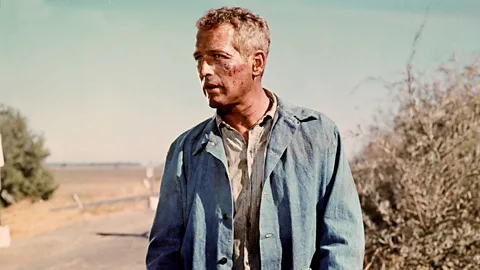 Alamy
AlamyThe humble barn jacket, chore coat and donkey jacket have all gone from functional workwear to "It-item". As a trend, is it a betrayal of the garments' US and UK working-class roots – or does it "honour the grit and resilience" that they represent?
The barn, chore and donkey jacket are now the holy trinity of cool coats. These workwear garments – once worn solely for the hard toil and physical graft of manual labour – are now the uniform de rigueur of big-city hipsters and fashionistas. But these modern wardrobe staples have a complicated and, at times, turbulent political and cultural history.
Rise of the barn jacket
Autumn is the season of the barn jacket, it seems, with Hailey Bieber, Dua Lipa and Alexa Chung among its fans. Vogue called the barn jacket an "It-item", The Guardian described it as "properly useful, but also visually pleasing", and Marie Claire touted it as "the only coat to wear right now".
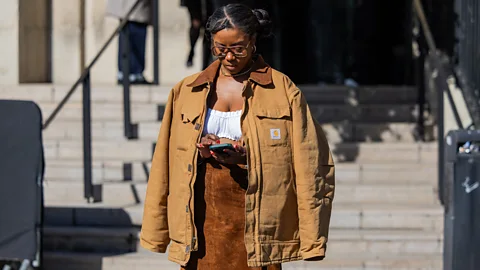 Getty Images
Getty ImagesRanging in colour from duck-egg green to deep maroon to Dijon mustard, the barn jacket can be recognised by its simplicity, functionality (implied by its name, it was originally worn for the messiness of mucking out stables) and roomy pockets.
Similar in aesthetic to that iconic British classic, the Barbour, the barn jacket took off following Prada's spring/summer 2024 catwalk show, but the ease with which the barn jacket fits into everyday life may be what has made it so popular and appealing.
"I just think there's an effortlessness that comes from these clothes. Which is kind of funny because it's workwear, made for manual work. It's functional. But it also has a real heart and soul," Albert Muzquiz tells the BBC. Muzquiz is a fashion historian and social media influencer; known on Instagram as EdgyAlbert, his TikTok video about chore coats has had more than 75,000 views.
Muzquiz is familiar with the politics of the US's workwear legacy brands – names like Carhartt and Dickies, and pioneers like Levi Strauss. Of course, these brands feature their own barn and chore jackets in their collections, like the Carhartt WIP's workaday Detroit jacket and the Dickies duck canvas chore coat, coats that celebrities and fashion fans have been wearing to either dress down a dress and a pair of stilettos, or to throw over jeans for a coffee morning run.
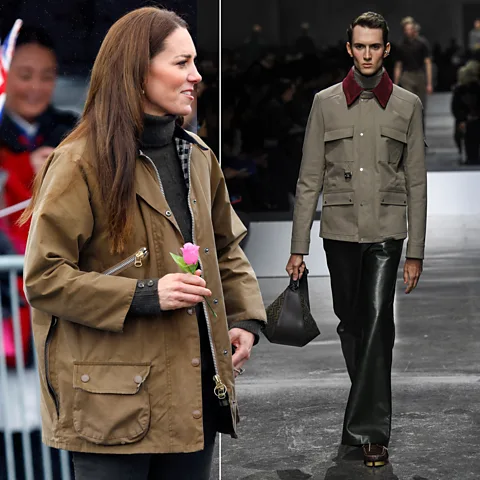 Getty Images
Getty ImagesBut why are they so popular now? "Right now, we're craving things with substance. And these workwear cuts are very flattering on a lot of people. They're very unisex, they're made to move with your body," Muzquiz tells the BBC. "I love this stuff because the history is so rich and it's also so ubiquitous. It's sort of like a love letter to a time that has passed [in the US] and will never come back, we had this time and it's gone.
"Things are not made with integrity in the same way that they used to be. And for a very reasonable price, if you're lucky and smart, you can have this piece of history that you can wear every day, and will go with everything."
The classic chore coat
Like the barn jacket, the chore coat also goes with everything.
The blue chore jacket was made to withstand the dirt and grime of working life. "Back in the day, you would get a brush and you would just brush off the dirt… garments would be an investment piece. And we are going back to that kind of mentality again," Mohsin Sajid, designer and denim historian, tells the BBC.
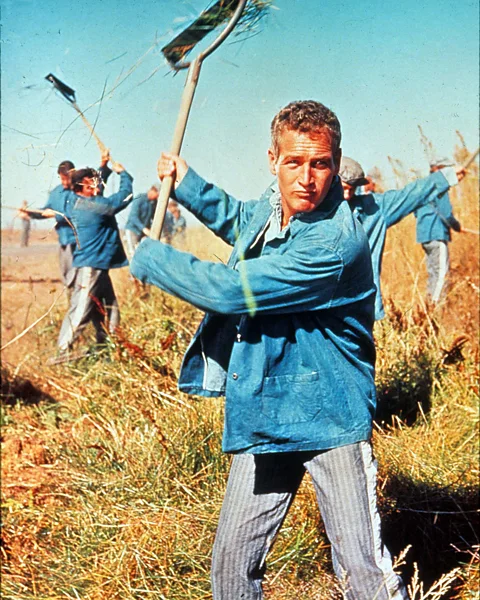 Alamy
AlamyThe original chore jacket or coat was a buttoned jacket with wide pockets and a collar; Paul Newman wore one in Cool Hand Luke. Thought to have originated in 19th-Century France, the jacket had a loose fit and wide pockets, made for carrying tools, and was indigo in colour, referred to as bleu de travail. From France, the chore jacket reached the US, where it was also worn for physical labour, such as railroad work. The blue of the chore coat eventually led to the term in the US "blue-collar worker".
So now that the chore coat is worn more frequently by those whose physical labour extends to plugging in a laptop, are we in danger of erasing a whole cultural history?
Are these uniforms of the working class being co-opted or appropriated by a (mostly) middle-class culture? "Once an item of clothing is taken out of its original context, it becomes an item of fashion," Doris Domoszlai-Lantner, a professor at the Fashion Institute of Technology, tells the BBC.
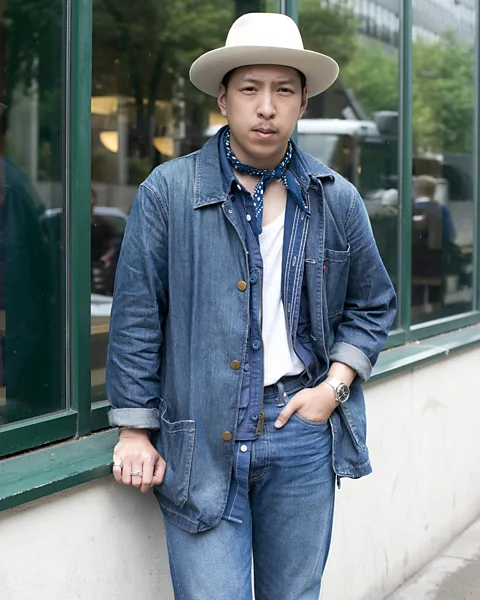 Getty Images
Getty Images"It's subject to the fashion cycle, and thus, the whims of popular opinion. This is currently the case with workwear such as barn jackets and chore coats which, as their name suggests, were originally created to add functional value to farm and manual labourers, with strategically positioned pockets and hammer loops. Some of the contemporary, fashionable versions don't include the features that are characteristic of these jackets in their original context. But this isn't the first time that workwear, a type of uniform, has made its way into fashion. Look at the 1970s-80s, when workwear was part of the antifashion statement worn by punks, which was then adopted into popular fashion.
Origins of the donkey jacket
The barn and chore jackets may be easily extricated from their working- class roots, but one jacket that wears its attitude firmly on its sleeve is the donkey jacket.
Worn by Cillian Murphy's coal merchant character in the recent film Small Things like These, the donkey jacket's visibility has also resurfaced with the 40th anniversary of the miners' strike this year, and documentaries commemorating it, with the jacket cropping up on the picket lines of England and Wales. Retailers and boutiques still sell them – Drake's donkey jackets fetch a whopping £995, a far cry from a miner's wages in 1984.
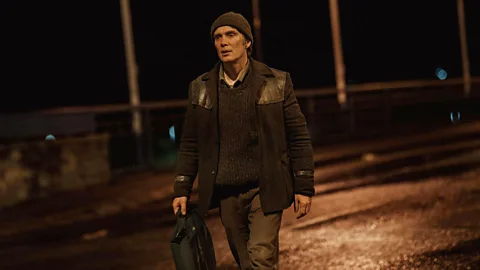 Alamy
Alamy"I'm sure the people that invented these workwear garments in the 1880s are probably turning in their grave going, 'Oh my God, £400, that's like five years' salary,'" Mohsin laughs.
But, according to Muzquiz, the idea that these pieces are ridiculously more expensive than their original iterations is largely a myth. "With any fashion statement, there are people wearing it in a sensitive way, and people who are playing dress up. We have become so numb to things costing so little… even when workwear was first used primarily for work, it was still often incredibly expensive. Buying a pair of Levi's for a miner in the early days was equivalent to a month or two month's wages."
The original donkey jacket was made of unlined black or dark blue dense Melton wool fabric, with a stiff collar and no vent at the back – making it perfect for protecting against cold, rugged weather and harsh conditions. Leather patches prevented the wool from wearing, as workers carried heavy items on their shoulders.
Despite its association with Welsh miners, the jacket actually originated in England. British draper George Key, from Staffordshire, designed it for navvies working on the construction of the Manchester Ship Canal, on the so-called "donkey engines", the steam-powered winches used in many industries, including mining, logging and maritime (hence the name).
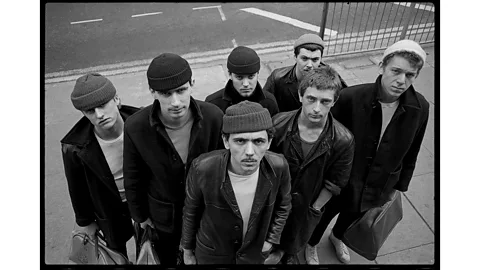 Getty Images
Getty ImagesSimon Whitaker, founder of Master Debonair, tells the BBC: "The donkey jacket has a real place in British working-class history, and I think it's one of those pieces that speaks volumes without saying a word. Originally, it was made for labourers who needed something tough and warm – practical and cheap. During the miners' strikes in the 1970s and 80s, it became an iconic symbol of unity and resilience. Bands like Bronski Beat and Dexy's Midnight Runners picked it up, wanting to show solidarity with that working-class grit. It was rugged, raw, and fit right in with their style.
"Now, seeing high-end brands like Drake's selling it for hundreds, even thousands, is a double-edged sword," says Whitaker. "On one hand, you could say it's class appropriation, taking a garment that came from necessity and turning it into a luxury item. But I actually think there's value in bringing these pieces into mainstream fashion. It keeps the history alive in a fresh way, and if done thoughtfully, it's a nod to the past, honouring the grit and resilience it represents."
The donkey jacket wasn't just a warm and practical jacket for down the mines and on the picket line: it also signalled exclusivity. Reddit user CrocodileJock tells the BBC: "The coolest thing about them was that you couldn't buy them anywhere. They were issued by various councils and utilities to workers, so you either got one because you had a manual labour job, or had a mate who had one."
 Drake's
Drake'sUnlike the barn or chore coat, the donkey jacket didn't quite transcend its working-class status, even when Labour MP Michael Foot was reported as having worn one at the Cenotaph (it was actually a "Jaeger coat from Harrods"), but it's still a powerful visual symbol of a turbulent time in British history.
More like this:
• Ten items in our wardrobe is enough – here's why
"I believe that workwear is more than a trend. I think that workwear is kind of something that has always been, and will always be, an important part of people's wardrobes," Muzquiz says.
The internet has democratised fashion, making it easier than ever to access trends and styles, but with that comes a sense of fashion fatigue. So it makes sense that many people are instead rebelling against fast fashion and seeking out classic pieces that transcend fleeting trends, and that are long-lasting, practical and timeless.
--
If you liked this story, sign up for The Essential List newsletter – a handpicked selection of features, videos and can't-miss news, delivered to your inbox twice a week.
